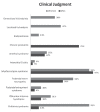Turn-amplitude analysis as a diagnostic test for myofascial syndrome in patients with chronic pelvic pain
- PMID: 25848846
- PMCID: PMC4391445
- DOI: 10.1155/2015/562349
Turn-amplitude analysis as a diagnostic test for myofascial syndrome in patients with chronic pelvic pain
Abstract
Background: Myofascial pain syndrome of the pelvic floor (MPSPF) is a common disease in the context of chronic pelvic pain (CPP); however, there is currently no gold-standard test to diagnose it.
Objective: To validate the turns-amplitude analysis (TAA) as a diagnostic test for MPSPF in patients with CPP.
Methods: A case-control study was performed, and patients were consecutively sampled within a specified period of time. A total of 128 patients were included: 64 patients with CPP (32 men and 32 women) and 64 control patients (32 men and 32 women). The same operator conducted all tests. Electromyography of the TAA is based on the collection of motor unit potentials that measure the number of changes in the signal and the mean amplitude of the changes. The electromyogram transfers the data to a graphical point cloud, which enables the patient's results to be compared with the results of the healthy subjects.
Results: In patients and control subjects, the sensitivity and specificity of the proposed diagnostic test showed a marked clinical significance: the sensitivity was 83%, and the specificity was 100%. A positive predictive value of 1 (95% CI 1 to 1) and a negative predictive value of 0.85 (95% CI 0.77 to 0.93) were observed.
Conclusion: TAA is a reliable diagnostic test to detect MPSPF. Further studies are needed to reproduce these results.
HISTORIQUE :: La douleur pelvienne chronique (DPC) s’associe souvent à un syndrome myofascial du plancher pelvien (SMPP). Cependant, il n’existe aucun test de référence pour le diagnostiquer.
OBJECTIF :: Valider l’analyse des inversions et de l’amplitude (AIA) comme test diagnostique du SMPP chez les patients ayant des DPC.
MÉTHODOLOGIE :: Dans le cadre d’une étude cas-témoins, les chercheurs ont recruté un échantillon consécutif de patients dans un délai déterminé. Au total, 128 patients y ont participé : 64 patients ayant des DPC (32 hommes et 32 femmes) et 64 patients témoins (32 hommes et 32 femmes). Le même opérateur a réalisé tous les tests. L’électromyographie de l’AIA repose sur la collecte de potentiels d’unités motrices qui mesurent le nombre de modifications au signal et leur amplitude moyenne. L’électromyogramme transfère les données sur un graphique en nuage de points, ce qui permet de comparer les résultats des patients à ceux des sujets en santé.
RÉSULTATS :: Chez les patients et les sujets témoins, la sensibilité et la spécificité du test diagnostique proposé avaient une signification clinique marquée. En effet, la sensibilité s’élevait à 83 %, et la spécificité, à 100 %. Les chercheurs ont observé une valeur prédictive positive de 1 (95 % IC 1 à 1) et une valeur prédictive négative de 0,85 (95 % ICI 0,77 à 0,93).
CONCLUSION :: L’AIA est un test fiable pour diagnostiquer le SMPP. D’autres études s’imposent pour reproduire les résultats de la présente étude.
Figures



Comment in
-
Letter to the Editor: Re: F Itza, D Zarza, J Salinas, F Teba, C Ximenez. Turn-amplitude analysis as a diagnostic test for myofascial syndrome in patients with chronic pelvic pain. Pain Res Manag 2015;20(2):96-100.Pain Res Manag. 2015 Nov-Dec;20(6):334. doi: 10.1155/2015/605896. Pain Res Manag. 2015. PMID: 26642071 Free PMC article. No abstract available.
-
The authors respond.Pain Res Manag. 2015 Nov-Dec;20(6):334-5. Pain Res Manag. 2015. PMID: 26985470 No abstract available.
References
-
- Fall M, Baranowski AP, Elneil S, et al. EAU guidelines on chronic pelvic pain. European Association of Urology. Eur Urol. 2010;57:35–48. - PubMed
-
- Bartoletti R, Cai T, Mondaini N, et al. Italian Prostatitis Study Group Prevalence, incidence estimation, risk factors and characterization of chronic prostatitis/chronic pelvic pain syndrome in urological hospital outpatients in Italy: Results of a multicenter case-control observational study. J Urol. 2007;178:2411–5. - PubMed
-
- Walter EA, Katon WF. The prevalence of chronic pain and irritable bowel syndrome in two university clinics. Psychosom Obstet Gynaecol. 1991;12:66–9.
-
- Mathias SD, Kupperman M, Liberman R, Steege JF, Lipshutz RC. Chronic pelvic pain: Prevalence, health-related quality of life, and economic correlates. Obstet Gynecol. 1996;87:321–7. - PubMed
-
- Pitts MK, Ferris JA, Smith AMA, Shelley JM, Richters J. Prevalence and correlates of three types of pelvic pain in a nationally representative sample of Australian women. Med J Aust. 2008;189:138–43. - PubMed
MeSH terms
LinkOut - more resources
Full Text Sources
Other Literature Sources
Medical
Research Materials

